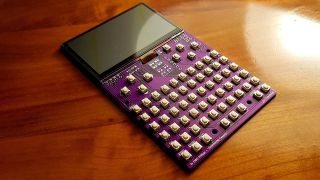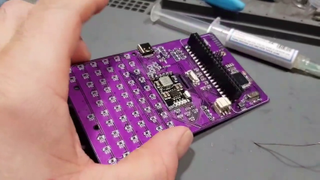Raspberry Pi Zero 2 W Based Pocket Computer Nears Crowdfunding Launch
Gorgeous, purple PCB packed with Pi

Looking rather like a pocket calculator or a Blackberry cell phone, this beautiful Raspberry Pi Zero 2 W-powered handheld computer from Twitter user Sulfuroid will be crowdfunding soon on the Crowd Supply website.
Ultra mini linux raspberry computer ! First power on .. Success !!!!!! @fast_code_r_us @Raspberry_Pi @Hacksterio @hackaday pic.twitter.com/Ni21TXZXxzJanuary 13, 2022
The brainchild of a maker we’ve featured before, the proposed handheld (which its maker refers to as a ‘Sharpikeebo’) has a familiar form factor. Seasoned followers of SBCs will notice a passing similarity to Pocket Chip, a $5 computer (and $75 PCB) which also used a custom PCB. Sulfuroid's projects uses a Sharp 2.7 inch 400 x 240px display, and has a full QWERTY keyboard, albeit with rather tiny keys (though not as tiny as some we’ve featured recently), and an RFM95 long range radio chip which operates at 868 MHz, that can be used for long range communications and control. In one tweet we can even see an external antenna for greater range. Long range communication capable pocket computers seems to be a popular topic for Raspberry Pi.
On the rear of the board we see a 40 pin header for the Raspberry Pi Zero 2 W's GPIO. This provides both power and data connectivity to the main PCB. The Pi Zero 2 W is inserted upside down, with the USB port point to the top of the board. Just under the header is space for a LiPo battery which will power the unit when on the move. To charge the battery we see a USB C port, and some form of voltage regulator / battery management chip.

The project has been in development for some time, and going through Sulfuroid's tweets we can see key moments in the development. On January 13 we see the first power on, booting to a terminal in Raspberry Pi OS (even though the console shows "Raspbian" in the top corner.) On the same day we see the unit soldered up and ready for testing, with the creator saying "So excited. With the new quality soldering station. I was able to solder the Sharpikeebo computer." A testament to the adage "the right tool for the right job." Another moment in the project's history is the obligatory "LED blinkies" test, again on January 13 (it seems this was a great day for the project) which sees the onboard 603 package LEDs tested.
The crowdfunding effort has yet to go live. Remember that crowdfunding a project is not a guarantee of receiving a finished product. Backing a crowdfunded project is akin to an investment, you believe in the project and want it to succeed. You are not purchasing a retail product.
Stay on the Cutting Edge
Join the experts who read Tom's Hardware for the inside track on enthusiast PC tech news — and have for over 25 years. We'll send breaking news and in-depth reviews of CPUs, GPUs, AI, maker hardware and more straight to your inbox.

Ian Evenden is a UK-based news writer for Tom’s Hardware US. He’ll write about anything, but stories about Raspberry Pi and DIY robots seem to find their way to him.
